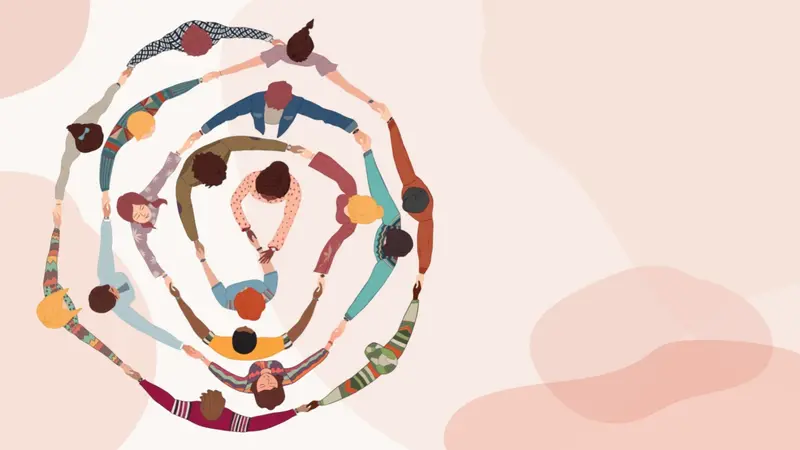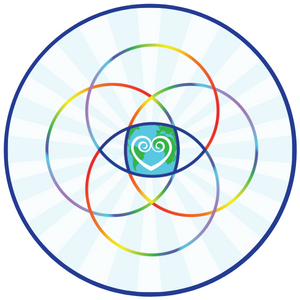

Chronic Conditions and Diseases

Chronic Conditions and Diseases
Health Effects of Social Isolation
by Hannah Tytus
Humans have an inherent need for social connection. Community is as vital to our well-being as food, water, and shelter. For much of human history, survival depended on mutual support and cooperation. Even today, human biology reflects this: the brain is hardwired to seek closeness with others.1 In early human societies, individuals depended on their community to meet basic needs, and living alone made survival much harder and more demanding.2 Although modern conveniences like food delivery, automation, and digital entertainment have made it easier to live without face-to-face interaction, the deep-rooted need for human connection still persists. Simply put, we need each other.
Social Connection
Social connection refers to the interactions, relationships, roles, and overall sense of belonging to communities and society.3 It is not defined by the number of close relationships, rather it is shaped by various forms of interaction and engagement—or the absence of them.4
Social connection is typically understood through three key components that play a crucial role in overall health and well-being5:
- Structure involves the number and types of relationships such as with friends, family, coworkers, or neighbors, as well as the frequency of interactions.
- Function refers to the level of dependence on others to meet emotional, practical, or social needs. Examples could include needs around mentorship or support in a crisis.
- Quality considers how positive, meaningful, and satisfying key relationships and interactions are, as opposed to being negative or unfulfilling. Social inclusion or exclusion can impact the quality of social connectedness.
People can experience a lack of social connection in a variety of ways, which are commonly studied through measures of loneliness and social isolation. While related, these two concepts are distinct. Social isolation refers to an objective lack of social relationships, roles, group involvement, and limited social interaction. In contrast, loneliness is a subjective feeling; it is the emotional discomfort that arises when there is a gap between the social connection someone wants and what they actually experience.6,7,8
Isolation Trends
In 2023, the Surgeon General of the United States released an advisory identifying loneliness and isolation as an epidemic, pointing to the widespread health harms of isolation and the healing effects of social connection and community.9,10 In recent years, about half of adults in America reported experiencing loneliness.11,12 A 2022 Gallup poll found that when people were asked how close they felt to others emotionally, only 39% of adults in the U.S. said that they felt very connected to others.13 In the last 20 years, Americans have become increasingly socially isolated, spending fewer and fewer hours per week connecting with family, friends, or neighbors.14
Drivers of Social Connections
Social connection is shaped by a range of factors across individual, relationship, community, and societal levels.15,16 At the individual level, physical and mental health, age, race, gender, socioeconomic status, and personality all influence one’s capacity to connect.17 Relationship structure, function, and quality also play a key role.
The community environment matters to social connections. Access to safe public spaces, transportation, schools, workplaces, and local organizations influence opportunities for interaction. These community assets are shaped by broader societal forces, including public policy, technology, economic conditions, and cultural norms.18,19,20,21 Social connection is not just a personal responsibility, it is also determined by the conditions in which people live, learn, work, and age.
Risk Factors for Social Isolation and Loneliness
While anyone can experience loneliness or social isolation, certain groups are at higher risk due to overlapping structural and individual vulnerabilities. These groups often face greater barriers to connection or are disproportionately exposed to conditions that reduce opportunities for social engagement.
- Health-related vulnerabilities. Individuals with poor physical or mental health, including those with disabilities or chronic conditions, are more likely to experience social isolation. Health challenges may reduce the ability to participate in social life or create stigmas that discourage others from engaging with them.
- Economic insecurity. People living in poverty or with low incomes often lack access to resources that support connections, such as transportation, digital access, or safe community spaces. For example, 63% of adults earning less than $50,000 per year report feelings of loneliness 10 percentage points higher than those earning more.22
- Living arrangements and caregiving responsibilities. People who live alone, including many older adults and single parents, face fewer daily opportunities for casual social interaction.
- Age. Although the highest rates of social isolation are seen among older adults,23,24 studies also show that young adults report significantly higher rates of loneliness: young adults are nearly twice as likely to feel lonely compared to those over age 65. Alarmingly, rates of loneliness among young adults have risen steadily from 1976 to 2019.25
- Social and cultural marginalization. Individuals from racial and ethnic minority groups, LGBTQ+ populations, rural residents, and those who face discrimination or stigma are often excluded—either implicitly or explicitly—from social, civic, or institutional participation. Experiences of racism, homophobia, or xenophobia can damage trust and reduce willingness or ability to engage socially.26
- Community infrastructure. Communities that do not provide the means for social interaction may reinforce or exacerbate the other risks. For example, communities lacking accessible public spaces, public transportation, or community programs may isolate residents further. Disinvestment in social infrastructure often affects already marginalized populations the most, compounding existing inequalities and reinforcing cycles of disconnection.
Importantly, these risk factors do not mean that certain identities or conditions inherently lead to loneliness or isolation. Rather, they reflect broader social, political, and economic systems that limit opportunities and reinforce disparities in access to connection. The uneven distribution of social capital and systemic barriers disproportionately affect certain groups, hampering their ability to forge meaningful connections and affecting their overall health.
Impacts of Social Connection on Health
The evidence is clear: social connection is a powerful predictor of health, and investing in relationships is essential for a longer, healthier life. Social ties not only enhance emotional well-being but also protect against many physical and mental health conditions.
Longevity
Social connection is a significant predictor of longevity as well as physical, cognitive, and mental health. In contrast, loneliness and social isolation place an individual at a much higher risk for premature death and poor health from a variety of conditions.27,28,29,30 A 2010 analysis published in PLOS Medicine of data across 148 studies, with an average of 7.5 years of follow-up, suggest “a 50% increased likelihood of survival as a function of stronger social relations.”31 Loneliness and social isolation increase the risk for premature death by 26% and 29%, respectively.32 In fact, the risks that loneliness and social isolation pose to health are comparable, and in some cases greater, than those of other risk factors. For example, a lack of meaningful social connection can raise the risk of early death to levels comparable with smoking 15 cigarettes per day.33 Social isolation as a predictor of mortality is similar to that of common clinical risk factors, including smoking, obesity, high blood pressure, and high cholesterol.34
Cardiovascular Disease and Hypertension
The evidence linking social connection to health is strongest for cardiovascular health outcomes. Dozens of studies have found that social isolation and loneliness increase the risk of heart disease and stroke.35,36 Inadequate or low-quality social ties are also linked to a higher likelihood of developing various health conditions, including a 29% greater chance of heart disease and a 32% higher risk of stroke.37
These impacts are not limited to older adults. In fact, research has found that social isolation in childhood is associated with increased risk of obesity, high blood pressure, and high blood glucose in adulthood, which are risk factors for cardiovascular disease.38,39 Further, heart failure patients who experienced high levels of loneliness faced a 68% greater risk of hospitalization, a 57% higher likelihood of visiting the emergency department, and a 26% increased chance of outpatient visits compared to those reporting low levels of loneliness.40
Hypertension (also known as high blood pressure) is one of the leading causes of cardiovascular disease.41 Multiple studies show that increased social support significantly reduces the likelihood of developing high blood pressure. Even among high-risk groups like Black Americans, strong social support is linked to a 36% lower long-term risk of hypertension.42
Consistent involvement in two or more social or community-based groups43, emotional and informational support from family, friends, professionals, community organizations, and peer groups44,45,46, as well as frequent interactions within one’s social network47, may enhance the management of hypertension. This includes better adherence to treatment plans and sustained lifestyle changes. Evidence from the National Social Life, Health, and Aging Project (NSHAP) at the University of Chicago, a longitudinal, population-based study of health and social factors of aging Americans, supports a potential causal link between social connections and reduced hypertension, especially in adults over the age of 50.48
Diabetes
Over the past 25 years, studies have shown that a person’s social life plays an important role in both the development and management of diabetes.49 Large studies have found that being socially connected can lower the risk of getting Type-2 diabetes and having complications from it.50 For example, being socially isolated—such as having little support from others51, living alone as a man52, having low emotional support as a woman53, or not having a partner after age 7054—has been linked to a higher risk of getting Type-2 diabetes.
Having support from family members helps people manage Type-1 and Type-2 diabetes better and improves their health.55 People who feel more connected to others often report better health and are better at managing their diabetes.56 On the other hand, people with smaller social networks are more likely to be newly diagnosed with Type-2 diabetes or to develop problems related to the disease.57
A review of 28 studies showed that support from family and friends was strongly linked to better self-care, especially when it came to checking blood sugar levels.58 Finally, 2018 research from the National Health and Nutrition Examination Survey, a population-based program conducted by the CDC that is designed to assess the health and nutritional status of American adults and children, found that older adults with diabetes who had at least six close friends were less likely to die from any cause.59
Infection/Respiratory Illness
Individuals with low levels of social connection may be more susceptible to infections and exhibit weaker immune responses. Studies have shown that loneliness and poor social support are associated with increased risk and severity of illness following exposure to viruses such as the common cold and influenza.60 In one study, participants exposed to a cold virus were significantly less likely to develop symptoms if they had ties across six or more different types of social relationships, such as being a parent, spouse, friend, family member, co-worker, or member of a group, compared to those with ties to only one to three types.61 In addition, individuals with weaker social bonds may be more vulnerable to viral infections and respiratory illnesses in general.62
Cognitive Function
Social isolation and loneliness place individuals at a greater risk for cognitive decline and dementia.63,64,65 In fact, chronic loneliness and social isolation can increase the risk of developing dementia by approximately 50% in older adults.66 One study, published in The International Journal of Geriatric Psychiatry, followed older adults for 12 years and found that those who reported being lonely experienced cognitive decline 20% faster than those who were well-connected socially.67 Wider social networks and more frequent social engagements with friends and family are associated with better cognitive function.68
Mental Health
Social disconnection is further connected to increased rates of mental health issues such as anxiety and depression.69 Both anxiety and depression are often characterized by withdrawal from social activities. At the same time, isolation and loneliness can predict increased risk for developing depression and anxiety and can worsen symptoms of each.
A systematic review of multiple longitudinal studies, published in Social Psychiatry and Psychiatric Epidemiology, found that adults who were lonely often had more than double the odds of developing depression compared to those who were not often lonely.70
Social isolation and loneliness have been shown to independently increase the likelihood of depression in older adults.71 These findings are consistent with isolation and loneliness in younger people: a 2020 review analyzed 63 studies and found that loneliness and social isolation among children increased the risk of both depression and anxiety. The duration of loneliness was more strongly associated with poor mental health than intensity of loneliness.72
Biological Mechanisms
The biology underlying the connection between social relationships and health is largely unknown. However, new research may illuminate some of the biological mechanisms behind social connection: A 2025 study, published in Nature Human Behaviour, found that social connections can enhance immune function and lower the risk of several chronic diseases. Researchers from the University of Cambridge and Fudan University analyzed blood samples from over 42,000 adults and identified 175 proteins linked to social isolation and 26 to loneliness (although, there was substantial overlap, with 85% of the proteins associated with loneliness being shared with social isolation). These proteins are associated with inflammation and immune responses, which are known to contribute to various health issues. Notably, five proteins were found to be directly influenced by loneliness, suggesting a causal relationship. One such protein, adrenomedullin, is linked to stress regulation and lower brain volume, which may increase the risk of early death. The study emphasizes the importance of maintaining social relationships for overall health and longevity.73
Social connection plays a central role in shaping health across the lifespan. Research shows that individuals with meaningful relationships experience lower risks of physical and mental health conditions. Loneliness and social isolation are associated with increased mortality and levels of biological markers linked to inflammation and disease. These effects are influenced by individual characteristics, relationship quality, community environments, and broader social and economic factors.
For related articles on this topic, see:
Americans Are Becoming Less Social
Researchers found that over time, people became more socially isolated and spent less time with family, friends, and others like neighbors or coworkers. Read more >>>
The Biological Basis Of Loneliness
New research involving over 42,000 adults from the UK Biobank suggests that social relationships may have a direct impact on physical health by influencing proteins in the blood linked to the immune system. Read more >>>
The Power of Community: Finding a Path to Meaningful Connection
Despite society’s increasing emphasis on individualism, the concept of community remains a powerful force for personal and collective well-being. Read more >>>
Overcoming Generation Z Loneliness: Prioritizing Human Interactions Over Screen Time
Generation Z, defined as those born between the mid-1990s and early 2010s, has grown up in a digital era characterized by constant connectivity, yet accompanied by profound isolation. Read more >>>
Pet Posse: Building a Network Around Our Animal Companions
A supportive community can play a crucial role in raising a pet by offering a diverse set of skills, resources and advocations that contribute to their comprehensive care. Read more >>>
Cutting Back on Social Media for Better Mental Health
A study published in the American Psychological Association’s journal of Technology, Mind, and Behavior demonstrates that limiting social media use to 30 minutes a day may impact psychological wellbeing. Read more >>>
Empathetic Phone Calls Shown to Reduce Loneliness in Older Adults
A study, published in JAMA Psychiatry, reveals that empathy-focused telephone calls helped older adults overcome loneliness. Read more >>>
Loneliness a Factor in Men’s Cancer Risk
A study by the University of Eastern Finland, published in Psychiatry Research, found that middle-aged men are at an increased risk of developing cancer if they are lonely. Read more >>>
Celiac Disease and the Dangers of Isolation
As people with celiac disease struggle to maintain a gluten-free diet, dietary restrictions can lead to isolation and withdrawal. Read more >>>
Loneliness: Health Effects and Coping Strategies
New studies have shown that the health effects of loneliness are far more serious than previously thought. Read more >>>
Whole Health Model Addresses Loneliness and Isolation in Older Adults
Older adults are especially prone to the negative effects of isolation and loneliness. Read more >>>
REFERENCES
[1] Tomova L, Tye K, Saxe R. The neuroscience of unmet social needs. Soc Neurosci. 2021;16(3):221-231.
[2] Coan JA, Sbarra DA. Social Baseline Theory: The Social Regulation of Risk and Effort. Curr Opin Psychol. 2015;1:87-91.
[3] National Academies of Sciences Engineering and Medicine (NASEM). Social Isolation and Loneliness in Older Adults: Opportunities for the Health Care System. Washington, DC: The National Academies Press; 2020.
[4] Badcock JC, Holt-Lunstad J, Bombaci P, Garcia E, Lim MH. Position statement: addressing social isolation and loneliness and the power of human connection. Global Initiative on Loneliness and Connection (GILC).2022.
[5] Holt-Lunstad J. Social Connection as a Public Health Issue: The Evidence and a Systemic Framework for Prioritizing the “Social” in Social Determinants of Health. Annual Review of Public Health. 2022;43(1):193-213.
[6] Prohaska T, Burholt V, Burns A, et al. Consensus statement: loneliness in older adults, the 21st century social determinant of health? BMJ Open. 2020;10(8):e034967.
[7] National Academies of Sciences Engineering and Medicine (NASEM). Social Isolation and Loneliness in Older Adults: Opportunities for the Health Care System. Washington, DC: The National Academies Press; 2020.
[8] Badcock JC, Holt-Lunstad J, Bombaci P, Garcia E, Lim MH. Position statement: addressing social isolation and loneliness and the power of human connection. Global Initiative on Loneliness and Connection (GILC).2022.
[9] https://www.hhs.gov/about/news/2023/05/03/new-surgeon-general-advisory-raises-alarm-about-devastati…
[11] Bruce LD, Wu JS, Lustig SL, Russell DW, Nemecek DA. Loneliness in the United States: A 2018 National Panel Survey of Demographic, Structural, Cognitive, and Behavioral Characteristics. Am J Health Promot. 2019;33(8):1123-1133
[12] Cigna Corporation. The Loneliness Epidemic Persists: A PostPandemic Look at the State of Loneliness among U.S. Adults. 2021.
[13] Gallup Inc., Meta. The State of Social Connections. Washington D.C.: Gallup Inc.,; 2022.
[14] Kannan V, Veazie P. US trends in social isolation, social engagement, and companionship —nationally and by age, sex, race/ethnicity, family income, and work hours, 2003–2020. SSM - Population Health. 2023;Volume 21.
[15] Office of Disease Prevention and Health Promotion. Social Determinants of Health. U.S. Department of Health and Human Services. Healthy People 2030 Web site. https://health.gov/ healthypeople/objectives-and-data/social-determinants-health. Published n.d. Accessed April 2023.
[16] National Center for Injury Prevention and Control, Division of Violence Prevention. The Social-Ecological Model: A Framework for Prevention. Centers for Disease Control and Prevention. https:// www.cdc.gov/violenceprevention/about/social-ecologicalmodel. html. Published 2022. Accessed April 2023.
[17] Kawachi I, Berkman L. Social Cohesion, Social Capital, and Health. In: Berkman L, Kawachi I, Glymour M, eds. Social Epidemiology. Second ed. New York City: Oxford University Press; 2014:174-190.
[18] Berkman LF, Glass T, Brissette I, Seeman TE. From social integration to health: Durkheim in the new millennium. Social Science & Medicine. 2000;51(6):843-857.
[19] United States Department of Health and Human Services. Community health and economic prosperity: Engaging businesses as stewards and stakeholders – A report of the Surgeon General. Atlanta, GA: U.S. Department of Health and Human Services, Centers for Disease Control and Prevention, Office of the Associate Director for Policy and Strategy; 2021.
[20] . Henry D, Gorman-Smith D, Schoeny M, Tolan P. “Neighborhood matters”: Assessment of neighborhood social processes. American Journal of Community Psychology. 2014;54:187-204.
[21] Lenzi M, Vieno A, Santinello M, Perkins DD. How neighborhood structural and institutional features can shape neighborhood social connectedness: a multilevel study of adolescent perceptions. Am J Community Psychol. 2013;51(3-4):451-467.
[22] Cigna Corporation. The Loneliness Epidemic Persists: A PostPandemic Look at the State of Loneliness among U.S. Adults. 2021
[23] Kannan V, Veazie P. US trends in social isolation, social engagement, and companionship —nationally and by age, sex, race/ethnicity, family income, and work hours, 2003–2020. SSM - Population Health. 2023;Volume 21.
[24] O’Sullivan R, Burns A, Leavey G, et al. Impact of the COVID-19 Pandemic on Loneliness and Social Isolation: A Multi-Country Study. International Journal of Environmental Research and Public Health. 2021;18(19):9982.
[25] Buecker S, Mund M, Chwastek S, Sostmann M, Luhmann M. Is loneliness in emerging adults increasing over time? A preregistered cross-temporal meta-analysis and systematic review. Psychological Bulletin. 2021;147(8):787.
[26] Cigna Corporation. The Loneliness Epidemic Persists: A PostPandemic Look at the State of Loneliness among U.S. Adults. 2021
[27] National Academies of Sciences Engineering and Medicine (NASEM). Social Isolation and Loneliness in Older Adults: Opportunities for the Health Care System. Washington, DC: The National Academies Press; 2020.
[28] Holt-Lunstad J. Why Social Relationships Are Important for Physical Health: A Systems Approach to Understanding and Modifying Risk and Protection. Annu Rev Psychol. 2018;69:437-458.
[29] Holt-Lunstad J. Social Connection as a Public Health Issue: The Evidence and a Systemic Framework for Prioritizing the “Social” in Social Determinants of Health. Annual Review of Public Health. 2022;43(1):193-213.
[30] Leigh-Hunt N, Bagguley D, Bash K, et al. An overview of systematic reviews on the public health consequences of social isolation and loneliness. Public Health. 2017;152:157-171.
[31] Holt-Lunstad J, Smith TB, Layton JB. Social relationships and mortality risk: a meta-analytic review. PLoS Med. 2010;7(7):e1000316.
[32] Holt-Lunstad J, Smith TB, Baker M, Harris T, Stephenson D. Loneliness and social isolation as risk factors for mortality: a metaanalytic review. Perspect Psychol Sci. 2015;10(2):227-237.
[33] Holt-Lunstad J, Robles TF, Sbarra DA. Advancing social connection as a public health priority in the United States. Am Psychol. 2017;72(6):517-530.
[34] Pantell M, Rehkopf D, Jutte D, Syme SL, Balmes J, Adler N. Social isolation: a predictor of mortality comparable to traditional clinical risk factors. Am J Public Health. 2013;103(11):2056-2062.
[35] Czajkowski SM, Arteaga SS, Burg MM. Social support and cardiovascular disease. In: Handbook of Cardiovascular Behavioral Medicine. Springer; 2022:605-630.
[36] Cené CW, Beckie TM, Sims M, et al. Effects of Objective and Perceived Social Isolation on Cardiovascular and Brain Health: A Scientific Statement From the American Heart Association. Journal of the American Heart Association. 2022;11(16):e026493.
[37] Valtorta NK, Kanaan M, Gilbody S, Ronzi S, Hanratty B. Loneliness and social isolation as risk factors for coronary heart disease and stroke: systematic review and meta-analysis of longitudinal observational studies. Heart. 2016;102(13):1009-1016.
[38] Caspi A, Harrington H, Moffitt TE, Milne BJ, Poulton R. Socially Isolated Children 20 Years Later: Risk of Cardiovascular Disease. Archives of Pediatrics & Adolescent Medicine. 2006;160(8):805-811.
[39] Danese A, Moffitt TE, Harrington H, et al. Adverse childhood experiences and adult risk factors for age-related disease: depression, inflammation, and clustering of metabolic risk markers. Arch Pediatr Adolesc Med. 2009;163(12):1135-1143
[40] Manemann SM, Chamberlain AM, Roger VL, et al. Perceived Social Isolation and Outcomes in Patients With Heart Failure. J Am Heart Assoc. 2018;7(11).
[41] National Center for Chronic Disease Prevention and Health Promotion. Heart Disease and Stroke. Centers for Disease Control and Prevention,. https://www.cdc.gov/chronicdisease/resources/ publications/factsheets/heart-disease-stroke.htm. Published 2022. Accessed April 2023.
[42] Harding BN, Hawley CN, Kalinowski J, et al. Relationship between social support and incident hypertension in the Jackson Heart Study: a cohort study. BMJ Open. 2022;12(3):e054812.
[43] Ueno T, Nakagomi A, Tsuji T, Kondo K. Association between social participation and hypertension control among older people with self-reported hypertension in Japanese communities. Hypertension Research. 2022;45:1-6.
[44] Magrin ME, D’Addario M, Greco A, et al. Social support and adherence to treatment in hypertensive patients: a meta-analysis. Ann Behav Med. 2015;49(3):307-318.
[45] Shahin W, Kennedy GA, Stupans I. The association between social support and medication adherence in patients with hypertension: A systematic review. Pharm Pract (Granada). 2021;19(2):2300.
[46] Pan J, Hu B, Wu L, Li Y. The Effect of Social Support on Treatment Adherence in Hypertension in China. Patient Prefer Adherence. 2021;15:1953-1961.
[47] Cornwell EY, Waite LJ. Social network resources and management of hypertension. J Health Soc Behav. 2012;53(2):215-231.
[48] Yang YC, Boen C, Gerken K, Li T, Schorpp K, Harris KM. Social relationships and physiological determinants of longevity across the human life span. Proc Natl Acad Sci U S A. 2016;113(3):578-583.
[49] de Wit M, Trief PM, Huber JW, Willaing I. State of the art: understanding and integration of the social context in diabetes care. Diabet Med. 2020;37(3):473-482.
[50] Brinkhues S, Dukers-Muijrers N, Hoebe C, et al. Socially isolated individuals are more prone to have newly diagnosed and prevalent type 2 diabetes mellitus - the Maastricht study. BMC Public Health. 2017;17(1):955.
[51] Altevers J, Lukaschek K, Baumert J, et al. Poor structural social support is associated with an increased risk of Type 2 diabetes mellitus: findings from the MONICA/KORA Augsburg cohort study. Diabet Med. 2016;33(1):47-54.
[52] Meisinger C, Kandler U, Ladwig KH. Living alone is associated with an increased risk of type 2 diabetes mellitus in men but not women from the general population: the MONICA/KORA Augsburg Cohort Study. Psychosom Med. 2009;71(7):784-788.
[53] Norberg M, Stenlund H, Lindahl B, Andersson C, Eriksson JW, Weinehall L. Work stress and low emotional support is associated with increased risk of future type 2 diabetes in women. Diabetes Res Clin Pract. 2007;76(3):368-377.
[54] Strodl E, Kenardy J. Psychosocial and non-psychosocial risk factors for the new diagnosis of diabetes in elderly women. Diabetes Res Clin Pract. 2006;74(1):57-65.
[55] de Wit M, Trief PM, Huber JW, Willaing I. State of the art: understanding and integration of the social context in diabetes care. Diabet Med. 2020;37(3):473-482.
[56] Wiebe DJ, Helgeson V, Berg CA. The social context of managing diabetes across the life span. Am Psychol. 2016;71(7):526-538.
[57] Brinkhues S, Dukers-Muijrers N, Hoebe C, et al. Socially isolated individuals are more prone to have newly diagnosed and prevalent type 2 diabetes mellitus - the Maastricht study. BMC Public Health. 2017;17(1):955.
[58] Song Y, Nam S, Park S, Shin IS, Ku BJ. The Impact of Social Support on Self-care of Patients With Diabetes: What Is the Effect of Diabetes Type? Systematic Review and Meta-analysis. Diabetes Educ. 2017;43(4):396-412.
[59] Lopreinzi PD, Ford MA. Effects of Social Support Network Size on Mortality Risk: Considerations by Diabetes Status. Diabetes Spectrum. 2018 May;31(2):189-192. doi: 10.2337/ds17-0056. PMID: 29773940; PMCID: PMC5951237.
[60] LeRoy AS, Murdock KW, Jaremka LM, Loya A, Fagundes CP. Loneliness predicts self-reported cold symptoms after a viral challenge. Health Psychol. 2017;36(5):512-520.
[61] Cohen S, Doyle WJ, Skoner DP, Rabin BS, Gwaltney JM, Jr. Social ties and susceptibility to the common cold. JAMA. 1997;277(24):1940-1944.
[62] Cohen S. Psychosocial Vulnerabilities to Upper Respiratory Infectious Illness: Implications for Susceptibility to Coronavirus Disease 2019 (COVID-19). Perspect Psychol Sci. 2020:1745691620942516.
[63] Penninkilampi R, Casey AN, Singh MF, Brodaty H. The Association between Social Engagement, Loneliness, and Risk of Dementia: A Systematic Review and Meta-Analysis. J Alzheimers Dis. 2018;66(4):1619-1633.
[64] Lazzari C, Rabottini M. COVID-19, loneliness, social isolation and risk of dementia in older people: a systematic review and meta-analysis of the relevant literature. Int J Psychiatry Clin Pract. 2021:1-12.
[65] Umeh K. Self-rated health and multimorbidity in patients with type 2 diabetes. J Health Psychol. 2022;27(7):1659-1678.
[66] Lazzari C, Rabottini M. COVID-19, loneliness, social isolation and risk of dementia in older people: a systematic review and meta-analysis of the relevant literature. Int J Psychiatry Clin Pract. 2021:1-12.
[67] Donovan NJ, Wu Q, Rentz DM, Sperling RA, Marshall GA, Glymour MM. Loneliness, depression and cognitive function in older U.S. adults. Int J Geriatr Psychiatry. 2017;32(5):564-573.
[68] Duffner LA, Deckers K, Cadar D, Steptoe A, de Vugt M, Köhler S. The role of cognitive and social leisure activities in dementia risk: assessing longitudinal associations of modifiable and nonmodifiable risk factors. Epidemiol Psychiatr Sci. 2022;31:e5.
[69] Mann F, Wang J, Pearce E, et al. Loneliness and the onset of new mental health problems in the general population. Soc Psychiatry Psychiatr Epidemiol. 2022;57(11):2161-2178.
[70] Mann F, Wang J, Pearce E, et al. Loneliness and the onset of new mental health problems in the general population. Soc Psychiatry Psychiatr Epidemiol. 2022;57(11):2161-2178.
[71] Domènech-Abella J, Mundó J, Haro JM, Rubio-Valera M. Anxiety, depression, loneliness and social network in the elderly: Longitudinal associations from The Irish Longitudinal Study on Ageing (TILDA). J Affect Disord. 2019;246:82-88
[72] Loades ME, Chatburn E, Higson-Sweeney N, et al. Rapid Systematic Review: The Impact of Social Isolation and Loneliness on the Mental Health of Children and Adolescents in the Context of COVID-19. Journal of the American Academy of Child & Adolescent Psychiatry. 2020;59(11):1218-1239.e1213.
[73] Shen, C., et al. (2025) Plasma proteomic signatures of social isolation and loneliness associated with morbidity and mortality. Nature Human Behavior. doi.org/10.1038/s41562-024-02078-1.


 By
By



